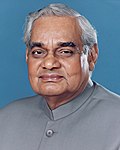
A | B | C | D | E | F | G | H | CH | I | J | K | L | M | N | O | P | Q | R | S | T | U | V | W | X | Y | Z | 0 | 1 | 2 | 3 | 4 | 5 | 6 | 7 | 8 | 9
| |||||||||||||||||||||||||||||||||||||||||||||
543 of the 545 seats in the Lok Sabha 272 seats needed for a majority | |||||||||||||||||||||||||||||||||||||||||||||
|---|---|---|---|---|---|---|---|---|---|---|---|---|---|---|---|---|---|---|---|---|---|---|---|---|---|---|---|---|---|---|---|---|---|---|---|---|---|---|---|---|---|---|---|---|---|
| Registered | 671,487,930 | ||||||||||||||||||||||||||||||||||||||||||||
| Turnout | 58.07% ( | ||||||||||||||||||||||||||||||||||||||||||||
| |||||||||||||||||||||||||||||||||||||||||||||
 Results by constituency | |||||||||||||||||||||||||||||||||||||||||||||
| |||||||||||||||||||||||||||||||||||||||||||||
General elections were held in India in four phases between 20 April and 10 May 2004. Over 670 million people were eligible to vote, electing 543 members of the 14th Lok Sabha.[1] Seven states also held assembly elections to elect state governments. They were the first elections fully carried out with electronic voting machines.
On 13 May the Bharatiya Janata Party (BJP), the lead party of the National Democratic Alliance conceded defeat.[2] The Indian National Congress, which had governed India for all but five years from independence until 1996, returned to power after a record eight years out of office. It was able to put together a comfortable majority of more than 335 members out of 543 with the help of its allies. The 335 members included both the Congress-led United Progressive Alliance, the governing coalition formed after the election, external support from the Bahujan Samaj Party (BSP), Samajwadi Party (SP), Kerala Congress (KC) and the Left Front.
After facing criticism from her own party and from the country, Congress President Sonia Gandhi asked the 22nd Finance Minister Manmohan Singh, an economist, to head the new government. Singh had previously served in the Congress government of Prime Minister P. V. Narasimha Rao in the early 1990s, when he was seen as one of the architects of India's first economic liberalisation plan, which staved off an impending monetary crisis. Despite the fact that Singh had never won a Lok Sabha seat, his considerable goodwill and Sonia Gandhi's nomination won him the support of the UPA allies and the Left Front. Manmohan Singh became the first Sikh and non-Hindu prime minister of India.
Background
Prime Minister Atal Bihari Vajpayee had recommended premature dissolution of the 13th Lok Sabha (in accordance with a provision of the Constitution) to pave the way for early elections apparently in view of the recent good showing of the BJP in the Assembly elections in four states.[3][4]
Organisation

The election dates for the parliamentary elections were:[5] [6]
- 20 April – 141 constituencies
- 26 April – 137 constituencies
- 5 May – 83 constituencies
- 10 May – 182 constituencies
Counting began simultaneously on 13 May. Over 370 million of the 675 million eligible citizens voted, with election violence claiming 48 lives, less than half the number killed during the 1999 election. The Indian elections were held in phases in order to maintain law and order. A few states considered sensitive areas required deployment of the armed forces. The average enrolment of voters in each constituency was 1.2 million, although the largest constituency had 3.1 million.
The Election Commission of India is responsible for deciding the dates and conducting elections according to constitutional provisions. The Election Commission employed more than a million electronic voting machines for these elections.
According to India Today, 115.62 billion rupees were expected to have been spent in campaigning for the elections by all political parties combined. Most of the money was spent on the people involved in the election. The Election Commission limited poll expenses to Rs. 2.5 million per constituency. Thus, the actual spending is expected to have been approximately ten times the limit. About 6.5 billion rupees are estimated to have been spent on mobilising 150,000 vehicles. About a billion rupees are estimated to have been spent on helicopters and aircraft.



